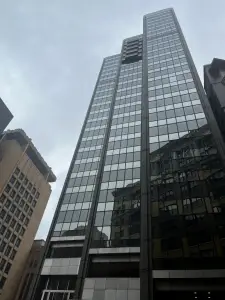A welcome St. Paul residential project exemplifies how buildings with varied pasts can find new life

The majority predictable thing about urban downtowns is that they will change Trends we take for granted the present day might reverse in a generation or two and even the buildings could see unpredictable futures To offer examples from downtown St Paul In the modern day s iconic Landmark Center full of museums and event spaces was originally a courthouse and post office The Lowertown neighborhood of apartments and still a sparse art studios was once uniformly warehouse factories and offices In the present day s post-modern Galtier Towers began as an urban shopping mall where I played mini golf and watched Reality Bites when it came out it then became an office tower and is now mostly quasi-residential emptiness The old Dayton s store now boasts a full-size top-floor hockey rink Unexpected uses emerge from the shells of old intentions At least that s what happens if you re lucky As you seemingly know the future of American downtowns once devoted almost single-mindedly to -to- commuter-based office districts lies in the great repurposing of those old spaces into something new Given the increasing vacancy of office space following the COVID pandemic this is why the downtown contemporary holy grail is the office-to-residential conversion Last month one of these projects opened in downtown St Paul and its story sheds light on whether or not office-to-residential conversions might save our downtowns Landmark s transformation Landmark Towers is a rather unassuming building the mirrored glass box you might not even notice if you glanced at the skyline The -story tower was built in as Amhoist Tower named for its original occupant Distinctive for the time it included five stories of condominiums atop the commercial office space The present day those central floors have been transformed into high-end apartments in the heart of downtown St Paul The project put together by local growth management company Sherman Associates is precisely the kind of thing both Twin Cities mayors are salivating over these days It s just a lot harder than finding a clean site out in the suburbs reported Will Anderson director of improvement for Sherman Associates You need to find partners both on the financing side and the municipal side You need to find a good contractor committed to doing this hard work because it is more challenging The intricate part of a conversion project lies in the financing footprints materials and retrofitting That was even more challenging in this scenario as the existing condo tenants on the top four floors of the building remained in place during the entire construction period The distribution of where the money goes is different than a new construction project Anderson declared A much higher proportion of costs goes to labor and paying contractors out on the site rather than material procurement in new construction The tower s evacuation plan illustrates the floorplan and building massing Note how numerous corner units there are Credit MinnPost photo by Bill Lindeke One general complication with this whole scenario is that generally speaking the design of a late th century office building suffers with residential use This isn t reliably true Landmark Towers is the exception that proves the rule but after World War II air-conditioning superblock scale modernist simplicity and large horizontal floor plates drove U S architecture Decisions that maximized the profit margin for post-war office towers have ironically made it prohibitively expensive to re-use these buildings for any other purpose Landmark Towers is the exception because it has a complex elaborated shape in the first place In other words this building is no rectangle There are lots of right angles and corners that make it ideal for fitting in apartments a happenstance factor that owes credit to the original top-floor condominiums Contrast this with Sherman s other project in downtown Minneapolis the Northstar Center Sherman Associates purchased it out of receivership in and has completed the entire rehab in under two years That s relatively quick for a downtown apartment tower There are a bunch of corner units Anderson explained The building initiatives back a number of times rather than an office building that is typically square that would lead to a necessity for kind of like longer deeper units with bedrooms without windows Landmark Towers offers sweeping views of St Paul as seen from this living room Credit MinnPost photo by Bill Lindeke The other key Landmark Towers variable was the financing invariably a complex stack of money from different sources In the matter alongside different investors and the city s use of million in tax-increment financing the developer added historic tax credits These are re-sellable tax benefits that come from the preservation of a historic building The building only dates to not typically old enough for historic designation but Sherman was able to acquire historic landmark status because of its connection to Amhoist a legendary St Paul business that dates back to the th century on the West Side flats A side note Amhoist which once built cranes for the Panama Canal came to a rather sad ending after the tower was built The company was devoured by predatory investors during the s one of several companies acquired by so-called vulture capitalists Nowadays a few of Landmark Towers elevators and lobbies retain their original material and historical materials But other than the reconstructed glass facade with million worth of less-tinted better insulated windows there s not a whole lot of history left in the building Instead there s a long list of luxurious amenities almost required for a high-end downtown residential industry two nicely detailed common areas a gym a virtual golf simulator an outdoor heated pool on the th floor and even a windowed sauna with an excellent view The common lounge area in Landmark Towers The building was erected in But the key amenity remains its central place in one of the nicest parts of downtown St Paul The building sits directly next to the St Paul Hotel and property manager Kalyah Kennedy was very eager to share with me that tenants can get St Paul Grill room institution delivered to their homes or discounted hotel rooms for visitors Meanwhile Rice Park sits right out of the apartment windows flanked by the neoclassical Latimer Library the Landmark Center the Ordway Center with the Mississippi River and its iconic high bridge in the background It makes for quite a view out your bedroom window That s one reason why Kennedy assured me that leasing is going great They have exceeded after just a month and so far tenants seem pretty happy with the price point and amenities in the new-old building On the other side of the ledger however downtown St Paul has certainly seen better days The city has experienced an economic nadir over the past year with the boarded-up shell of the Lowry Hotel building a block away only the majority proximate sign There s not a downtown grocery store anymore and there s a long list of other problems that have been a long time coming That s perhaps why so several downtown folks have greeted the new apartment tower with delight It s a positive sign in a city that sorely demands one More downtown St Paul conversions coming For downtown St Paul like various other American downtowns the next decade will be an awkward dance Specific properties will lose value to almost nothing others will lose value but gain prospective and others might see a rebirth It will likely make for an uneven chaotic situation something already visible in St Paul where mid-century skyscrapers like the massive Alliance Bank tower sit abandoned three blocks away Lacking the small-scale spaces that make for good apartments that property seems like a lost cause At the same time downtown St Paul boasts plenty of older more adaptable buildings that Anderson suggested have caught the eye of Sherman Associates I demanded him if they were going to do another office-to-residential conversion project like Landmark Towers Yes absolutely we are looking at historic conversions in all of our markets right now Anderson assured me I think it s worthwhile you know because the impact is so great and the need is so great The only catch and apparently the No variable for an office-to-residential success is the price point Existing buildings have to continue to drop in value until they bottom out and only then will the adaptable ones get reused In other words it won t be a smooth transition but that s the uncomfortable dance of downtowns these days Perhaps unfortunately this means that downtown s death-and-life cycle is only just beginning The post A welcome St Paul residential project exemplifies how buildings with varied pasts can find new life appeared first on MinnPost


